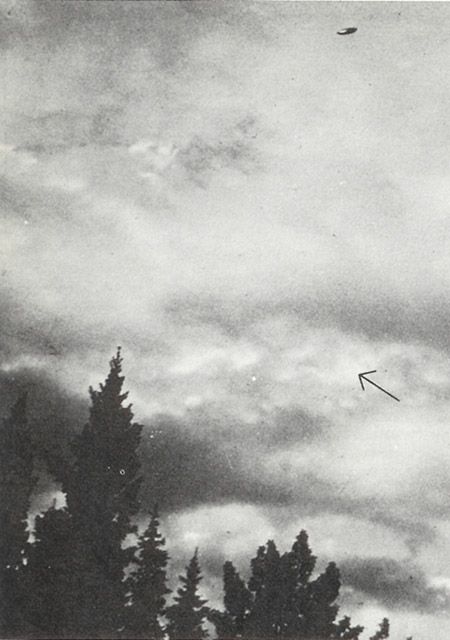Date:
July 3, 1967
Location: Calgary, Alberta, Canada
Of
the 35 photographic cases examined by the Condon Committee,
only two were judged to be "first priority"
-- having potential value in establishing the existence
of "flying saucers." One was the so-called Calgary
case with its two photos. Dr. Hynek, who subjected the
original negatives to exhaustive lab tests, called the
first photo the "best Daylight Disc photograph I
have personally investigated."


A
daylight disk photographed by Warren Smith on 3 July 1967.
Smith and two companions were in the foothills of the
Rocky
Mountains, southwest of Calgary, Alberta, returning from
a weekend prospecting trip. J. Allen Hynek and the Royal
Canadian Air Force Defense Photographic Interpretation
Center considered the picture genuine.
Source:
Knight
Of
the 35 photographic cases examined by the Condon Committee
(pp.168-9), only two were judged to be "first
priority" -- having potential value in establishing
the existence of "flying saucers." One
was the so-called Calgary case with its two photos. Dr.
Hynek, who subjected the original negatives to exhaustive
lab tests, called the first photo (above) the "best
Daylight Disc photograph I have personally investigated."
Fifty miles southwest of his home in Calgary, Alberta,
Warren Smith and two friends were returning from a weekend
prospecting trip through rugged "bush"
country on July 3, 1967. At about 5:30 p.m., the youngest
of the group pointed to what at first all thought was
an airplane. It was some two miles away at about 2000
feet -- but losing altitude fast, as if headed for a crash.
As it traveled toward them, they noticed it had no wings.
"...It passed slightly out of view behind some
trees," went Smith's deposition, to which he
swore under the Canada Evidence Act, "...then
reappeared and hovered in the open sky, and something
of a much smaller size fell from the craft."
In the 25 seconds the object was in view, Smith remember
the loaded camera in his pack. "I ... took two
pictures of this strange craft and swear... no other humans
were in that area" and "no camera tricker"
was involved, he stated. The object was described as circular,
shiny, and about 25 feet wide. Arrows point to a small
cloud formation virtually unchanged in both photos, proof
of Smith's claim that the shots had been taken only seconds
apart. Hynek, who flew over the site with Smith, found
no evidence of a hoax in his investigation.
Source:
http://www.ufoevidence.org/cases/case412.htm
